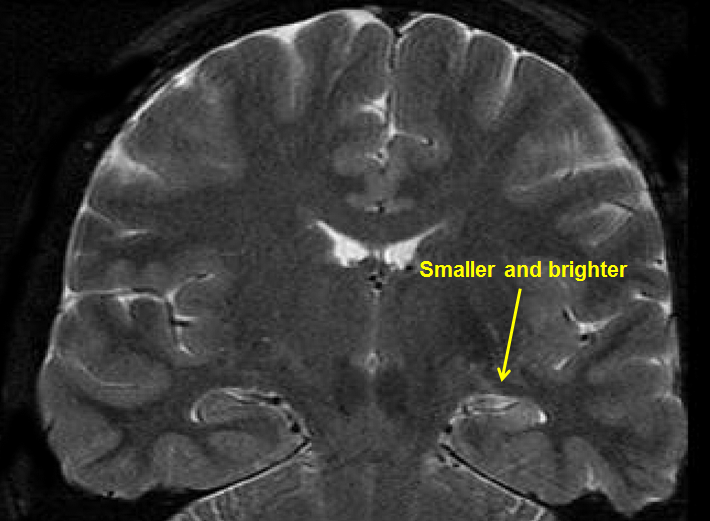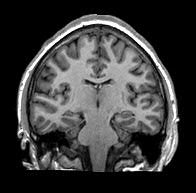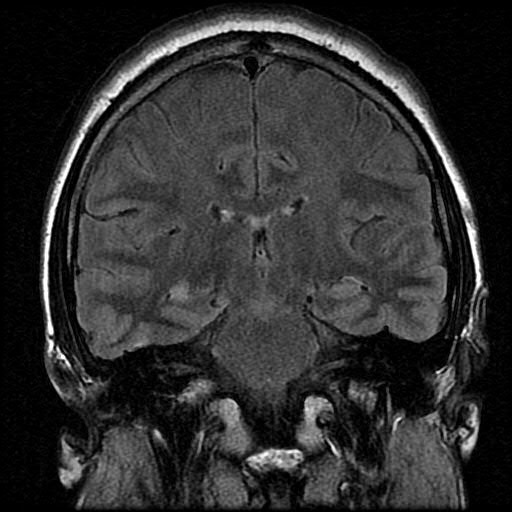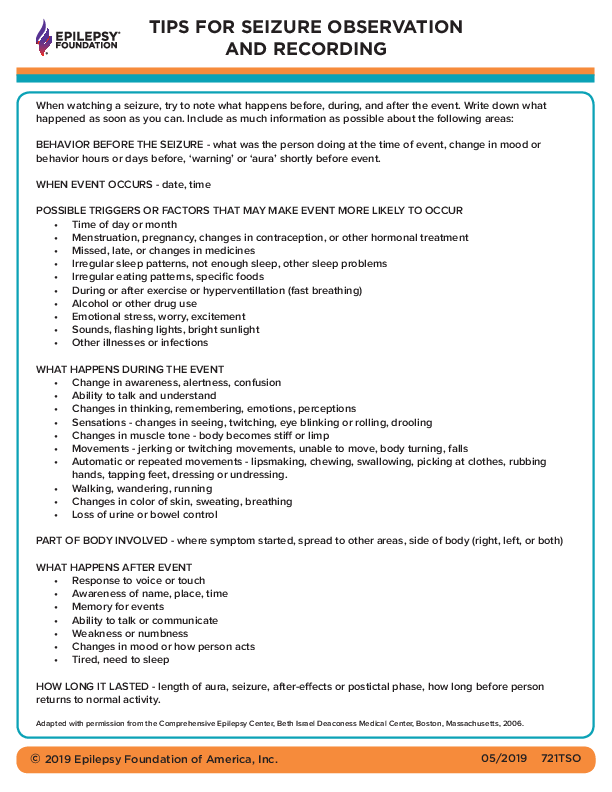Temporal Lobe Epilepsy (TLE)

Medial TLE can be associated with hippocampal sclerosis, as shown on the MRI scan above.
What Is Temporal Lobe Epilepsy (TLE)?
Temporal lobe epilepsy is the most common form of focal epilepsy. About 6 out of 10 people with focal epilepsy have temporal lobe epilepsy. Seizures in TLE start or involve in one or both temporal lobes in the brain.
Learn More:
Contact Our HelplineThere are two types of TLE:
- Mesial temporal lobe epilepsy (MTLE) involves the medial or internal structures of the temporal lobe. Seizures often begin in a structure of the brain called the hippocampus or surrounding area. MTLE accounts for almost 80% of all temporal lobe seizures.
- Neocortical or lateral temporal lobe epilepsy involves the outer part of the temporal lobe.
Medial temporal lobe epilepsy usually begins around age 10 or 20, but it can start at any age. Usually a person has had a seizure with fever or an injury to the brain in their early years.
There are a lot of older names for seizures that occur in TLE, including "psychomotor seizures," "limbic seizures," "temporal lobe seizures," "complex partial," and "simple partial." The modern name for these seizures is "focal onset seizures." Focal seizures are then described by whether a person stays awake and aware or has impaired awareness during a seizure.
Mesial temporal lobe epilepsy is often associated with changes or abnormal findings on MRI (magnetic resonance imaging). One of the most common findings is scarring in the temporal lobe. This is called hippocampal sclerosis (sclerosis means hardening or scarring). It may look like the hippocampus on one side, or both, has shrunk or is smaller.

Right Mesial Temporal Sclerosis (MTS)

Right Mesial Temporal Sclerosis (MTS) with Flair
Also, see arrow in figure at the top of the page.
When the MRI is abnormal, seizures often do not stop with medication. In this case, surgery to remove the area causing the seizures is the best option for many people.
- This is especially true when hippocampal sclerosis is on the side of the brain that is not involved with language. This is called the non-dominant side of the brain, which for most people is the right side.
- Neuropsychological testing is important for any person considering epilepsy surgery. Testing helps guide doctors, people with epilepsy, and families about possible cognitive risks (attention, memory, and learning) compared to benefits of seizure control.
What Type Of Seizures Are Seen?
Seizures in TLE include focal aware seizures, such as auras, and focal impaired awareness seizures.
- Auras are the same as focal aware seizures. They used to be called simple partial seizures. They are the first symptoms of a seizure.
- The most common auras are feelings of déjà-vu or some stomach upset.
- Feelings of fear, panic, anxiety, a rising sensation coming from the stomach to the chest or throat, or butterflies with nausea are other common auras.
- Some people may sense an unusual smell. This symptom may raise the possibility of a lesion or tumor in the hippocampus of the temporal lobe.
- Sometimes the auras can be very hard to describe.
Focal impaired awareness seizures used to be called complex partial.
- During this type of seizure, a person may have a fixed stare, be unaware or confused about what is going on around them, have fumbling with their fingers, or lip-smacking movements. The seizures last 30 seconds to a couple of minutes.
- There can be unusual posturing (movement or positioning) in an arm. This can help identify where seizures start in the brain.
- Some people also speak gibberish or lose their ability to speak in a sensible manner. Language problems are more common if the seizures are coming from the dominant temporal lobe.
- The focal seizure can go into generalized tonic-clonic jerking. The person may be weak after the seizure has stopped.
- Some people can also have prolonged seizures. Rarely, repeated or long seizures called status epilepticus may develop.
- Seizures in neocortical or lateral temporal lobe epilepsy often start with an auditory aura, such as buzzing or hearing a specific sound.
A Typical Story
"I get the strangest feeling – most of it can`t be put into words."
"The whole world suddenly seems more real at first. It's as though everything becomes crystal clear. Then I feel as if I'm here but not here, kind of like being in a dream. It's as if I've lived through this exact moment many times before. I hear what people say, but they don't make sense. I know not to talk during the episode, since I just say foolish things. Sometimes I think I'm talking but later people tell me that I didn't say anything. The whole thing lasts a minute or two."
What Are Some Risk Factors For Temporal Lobe Epilepsy?
Common risk factors that lead to developing TLE include
- Brain injury including head trauma with loss of consciousness, birth injury, infections such as encephalitis or meningitis that happen early in life
- Changes in the structure of a temporal lobe, such as brain malformations or tumors
- The most common risk factor is a prolonged or focal febrile seizure.
- About 2 out of 3 people with TLE have had a history of febrile seizures.
- Three out of 4 of these were either prolonged or had complex features.
- It is important to know that the vast majority of people with febrile seizures do not develop temporal lobe epilepsy.
How is TLE diagnosed?
Medial temporal lobe epilepsy is a clinical diagnosis. This means that a number of factors are put together. There isn’t one test for TLE.
- It’s important to listen to a person describe their seizures in as much detail as possible or by hearing observations of a witness.
- An MRI of the brain should be done to look for changes in the temporal lobe.
- An EEG (electroencephalogram) should be done and often shows spike or sharp waves in the tip or front of the temporal lobe. These can be seen when a person is awake or asleep.
- When seizures arise in more mesial (middle) temporal lobe areas, the EEG may only show rhythmic slowing during seizures. These may be hard to diagnose unless a typical seizure is recorded on the EEG.
Download these forms to help record and describe seizures:
How is TLE treated?
Seizure Medications
Many people with temporal lobe epilepsy achieve full seizure control with anti-seizure drugs. But almost a third of people may not respond to drug therapy.
Uncontrolled seizures may cause a number of problems. For example, people often report problems with memory, socialization, and a fear of leaving their home. They may restrict their daily activities, which leads to a decrease in quality of life.
Surgery
If seizures fail to respond to medication, then epilepsy surgery may be an option. When an MRI shows hippocampal sclerosis in the medial temporal lobe and EEGs show seizures starting in that same area, seizures may be cured by surgery. In some cases, up to 7 out of 10 people can be seizure-free after surgery with few problems afterwards.
Devices
If surgery is not possible or doesn't work, devices such as vagus nerve stimulation (VNS) or responsive neurostimulation (RNS) may help.
Finding The Right Treatment
- Talking with your health care team about your seizure control and how seizures affect your life is the first step in finding the best treatment plan.
- Consider seeing a neurologist who specializes in epilepsy (called an epileptologist) and have an evaluation at an epilepsy center to explore all treatment options, including surgery, devices, and dietary therapy. There may also be ongoing clinical trials looking at new treatment options.
- Anyone with TLE who has had breakthrough seizures after trying 2 or more antiseizure drugs should be seen by an epileptologist at an epilepsy surgery center as early as possible.
- The sooner a person is seen for surgical evaluation, the greater chance of success from surgery.
What Is The Outlook?
Two out of 3 people with temporal lobe epilepsy achieve good seizure control with seizure medication. Seizures may also go away in some children with TLE. A good outcome is most often seen in people with normal MRI scans.
If the MRI is abnormal, there is a much higher risk that seizures will not respond to medicines (called drug-resistant epilepsy or DRE). Overall, the prognosis for people with drug-resistant medial temporal lobe epilepsy includes a higher risk for memory and mood problems, lower quality of life, and an increased risk for sudden unexpected death in epilepsy (SUDEP). If surgery can be done to control seizures, these risks and problems can be improved.
Learn More:
Donate to Support Our MissionResources
Epilepsy Centers
Epilepsy centers provide you with a team of specialists to help you diagnose your epilepsy and explore treatment options.
Epilepsy Medication
Find in-depth information on anti-seizure medications so you know what to ask your doctor.
Epilepsy and Seizures 24/7 Helpline
Call our Epilepsy and Seizures 24/7 Helpline and talk with an epilepsy information specialist or submit a question online.
Tools & Resources
Get information, tips, and more to help you manage your epilepsy.









